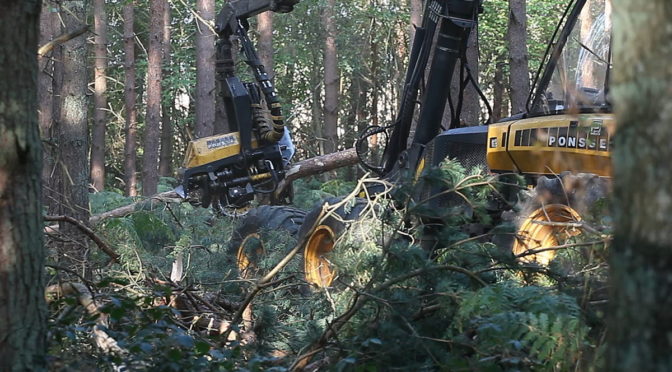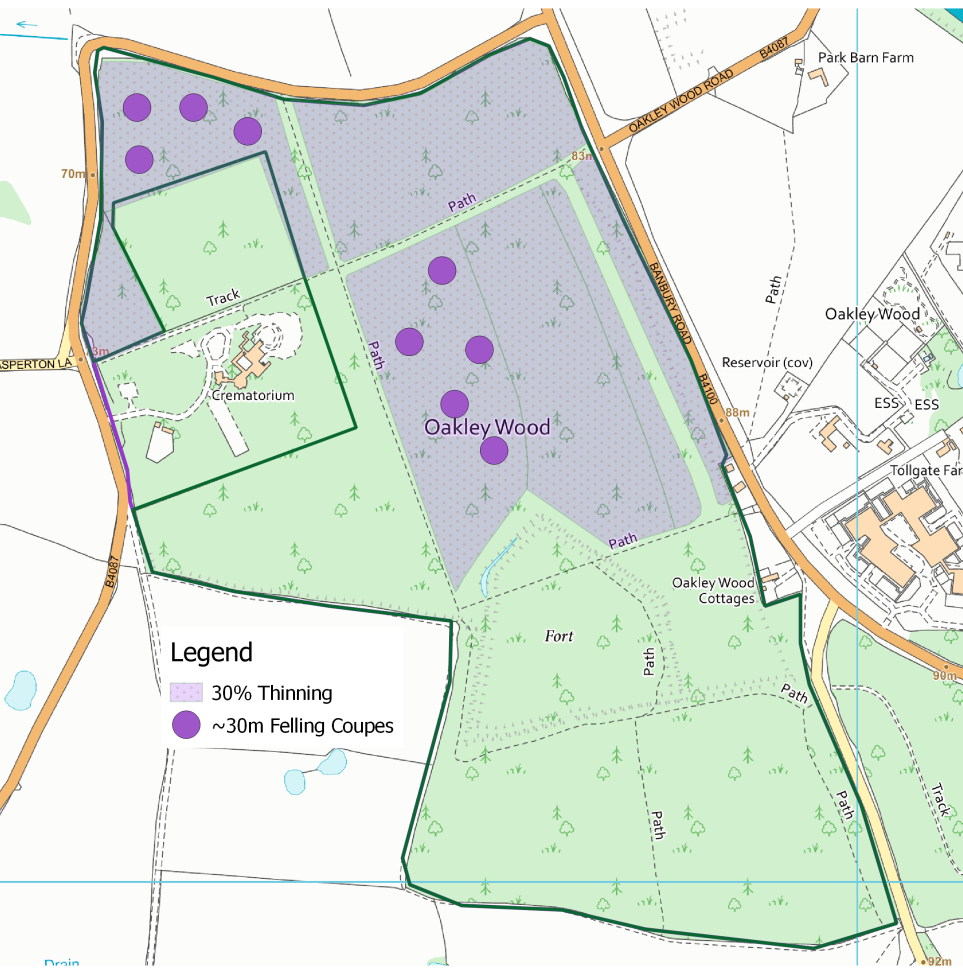Restoring our native woodlands for people and wildlife
(This article is based on information provided by Karl Curtis of the Warwickshire Wildlife Trust)
Oakley Wood was clear felled just after the second world war to provide much needed hardwood for building work, pit props and fuel to get the nation back on its feet. Years later, to fulfill the continuing demand, the wood was over-planted with fast growing conifer species which were dominant at the time it was purchased by Warwick District Council.
The process of returning it to a native, broad-leaved woodland began in 2011 with major thinning operations. This was followed in 2014 with further thinning and work to widen the rides, the main paths through the wood. Regular visitors will be aware of ongoing ride work than has been undertaken over the last 5 years, improving the woodland edge corridors around the path network to let native species thrive again.
Warwickshire Wildlife Trust who manage the wood on behalf of WDC has produced a 10-year plan, approved by the Forestry Commission, that aims to return Oakley to a broad-leaved wood , the overall vision being to develop a vibrant woodland for the benefit of local people, rich and diverse in wildlife, and sustainably managed.
The next phase of the work, starting this autumn, will be to thin certain areas where conifer trees dominate in order to promote the establishment of native species. This will be done by taking out around one third of the trees across selected areas, favouring the retention of native broad-leaved species. These areas are in the north and east of the wood – details of where the work is taking place can be seen on the map below.
In the areas with the highest proportion of conifers and where natural regeneration of broad-leaved trees would therefore be unlikely, nine 30 m holes (“coupes”) will be punched in the wood to create clearings where native broad-leaved species can be planted after operations are complete. These openings will start to provide age and structural diversity in the wood, as woodlands that are the healthiest have a variety of stages of growth and a diversity of species, helping them be resilient to disease and climate change.
The work will be carried out by contractors and whilst woodland management can look destructive and cause some temporary inconvenience around access, the woodland soon recovers. During the work the contractors will avoid using the path network wherever possible and any areas that are disturbed that are used by the public will be put right at the end of the operations. Paths through the areas affected are likely to be closed at times. Visitors are asked to take precautions, stay away from timber stacks and adhere to any warning signs.
Woodland management is essential for the future enjoyment of people and wildlife – woodlands live in hundreds of years as opposed to decades. One of the biggest threats to woodlands is not managing them, and therefore we appreciate your patience and understanding whilst this vital work is carried out.
If you have any questions, contact this site or Warwickshire Wildlife Trust via their website at www.warwickshirewildlifetrust.org.uk



Great work with the management.
Please also think about taking on the sycamores. They are taking over, so far, only a small part of the wood, but every year there are 100s of new saplings. They cast a very dark canopy preventing plans from growing underneath and support very few insects (see http://www.countrysideinfo.co.uk/woodland_manage/tree_value.htm).
Dear sirs.
Just an observation.
On the left hand side of the B 4087, as one leaves the B4100, just prior to the sharpest left hand bend in Warwickshire , there are a line of beautiful Lime trees, with the worst example of neglect of a hedge seperating them, with overgrown ivy clinging to dead tree stumps.
As a regular traveller along that road, and also the owner of a well cared for hedge, that also abuts the same road, I really do think WDC should look at the example set by most Warwickshire Farmers, and put their house in order, and care for the approach to the Crematorium, as a token of respect for mourners .
A fair comment perhaps. However, it may be that WDC view the boundary of the wood as part of the wood as a whole, and therefore not want to treat it differently. This is my personal opinion though, and it’s for Warwickshire Wildlife Trust and Warwickshire District Council to decide on these matters.
I’ll pass on your comments to WWT. You can pass your comments directly to WDC by emailing them to .
Let me just start by stating the obvious: I am not an expert in woodland management. I understand the aim of the plan ; however, we are currently facing alarming CO2 levels and air pollution. As far as I understand, the trees that are to be felled (30% in the marked up areas seems to be a lot, especially if the areas will look like the south areas where previous thinning happened) are still alive and therefore still absorbing CO2 and PM particles. In order to have any hope of one day reversing climate change and air pollution, (many) more trees need to be planted (especially in Warwickshire which has an important agricultural/farming density). Why not focusing funding and efforts on reforestation/rewilding of Warwickshire instead of cutting good trees for bringing back native trees? I am sure I am being too simplistic but I hope you can understand my point.
First, be aware that plans for the long term management of Oakley Wood are developed by WDC and WWT, and approved by the Forestry Commission. The Friends of Oakley Wood have little influence over these plans. Concerns over the strategy should probably be directed to WWT in the first instance.
Having said that, I can offer my personal thoughts. We all are, or should be, worried about global warming, so I appreciate your concern about any reduction in tree coverage. In fact, many of us in The Friends were unhappy about trees being cut down at all. However, from the outset of Warwick District Council’s ownership, the intention has been to return the wood to largely broad-leaved coverage, which was its original state before being turned into a mostly coniferous plantation during the last century. This is good for biodiversity, and although it meant initially removing a number of trees (many were overcrowded and some unhealthy) and leaving the wood looking a bit like a war zone, the benefits are already beginning to show. Most important, from the point of view of your concern, is that deciduous trees are estimated to be 50% better than conifers at removing CO2 from the atmosphere (search “Forests not equal when it comes to climate” for articles on the subject) and while they may be a dip in CO2 extraction in the short term (although the newly created understorey will go some way to compensate for this), the longer term benefits are clear.
So hopefully things are better than you thought. It would be great to have more land to plant more trees, but at least we can try to make best use of the land we have.
So if the plan is to return the Oakley Woods to mainly broad leave trees, why are there so many Oak trees with a large green X painted on them. I presume these are to be felled?
Good question. I’ve forwarded it to WWT and I’ll post their reply.
WWT have replied: “Those marks are to demark the scheduled ancient monument and are a marker to remind the contractors not to fell those trees or enter that area.” Hopefully that puts your mind at rest.
Thats good but what are the orange paint marks. Also if the felling is to support and enhence broad leave tress, why are the cutting down Oaks and Silver Birch??
In the article Karl has written:
“The next phase of the work, starting this autumn, will be to thin certain areas where conifer trees dominate in order to promote the establishment of native species. This will be done by taking out around one third of the trees across selected areas, favouring the retention of native broad-leaved species.”
So this does indicate that some broad-leaved trees will be included, although I’ve no idea exactly how this is micro-managed. I assume that WWT will have been involved in the decisions and not just left to the whim of the contractor. I’ll invite them to comment here if they have something to add.
Karl has kindly sent me this:
We are taking out some (but only a small number) of oaks and birch to diversify the structure of the woodland. Even a lot of the broadleaved trees in there are aged and so to allow some of the better specimens of broadleaves to grow on, and to allow younger trees that will fill those gaps, we do need to take out the occasional broadleaved tree. Again, this is a small number and will also be within the openings that are being created that will allow younger trees to grow on; in time that will strengthen the woodland’s age and structural diversity and make it more resilient to pests and diseases and climatic change. Some of these will be left as deadwood which Oakley lacks and is an important part of the woodland cycle.